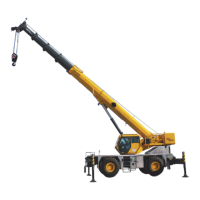HYDRAULIC SYSTEM TMS800E SERVICE MANUAL
2-74
Published 01-29-2014, Control # 496-00
OUTRIGGER STABILIZER CYLINDER
Description
The four outrigger stabilizer cylinders (see Figure 2-51) each
have a hollow rod for internal porting. Each cylinder has a
13.9 cm (5.50 inch) diameter bore. A port block is welded to
the rod of each cylinder and a pilot operated check valve is
threaded into each port block.
The retracted length of the cylinder from the end of the barrel
to the center of the rod’s port block rod bushing is 109.50
±0.30 cm (43.12 ±0.12 inches). The extended length of the
cylinder from the end of the barrel to the center of the rod’s
port block rod bushing is 160.30 cm (63.12 inches). Its stroke
is 50.8 cm (20.0 inches).
A wiper ring in the head prevents foreign material from
entering the cylinder. O-rings and other seals prevent
internal and external leakage.
The cylinder weighs approximately 100.2 kg (220.4 lb) dry.
Maintenance
Disassembly
NOTE: Any maintenance requiring disassembly of the
cylinders should include replacement of all cylinder
seals.
1. Clean away all dirt from the head. Place protective
padding around the rod near the head to prevent
damaging the chrome. Using a spanner wrench,
unscrew the head from the barrel.
2. Open ports on the side of the cylinder barrel and drain
the oil from the cylinder.
3. Secure cylinder barrel in a chain vise without putting
pressure on the side feeder tube in the vertical position
with the rod assembly up.
4. Remove the setscrew on the barrel OD at the head.
NOTE: Oil or oil/air mixture may rapidly exit out of the ports
during rod extension. Shield the work area from the
exiting oil.
5. With the ports open, extend the rod assembly with a
hoist enough to access the top of the head with spanner
wrench. Do not extend completely.
6. Turn the head counterclockwise with a fitted spanner
wrench until the threads disengage.
7. Extend the rod assembly slowly until the piston is free of
the barrel assembly. Place the rod assembly horizontally
on a workbench taking care not to damage the surface
of the rod.
NOTE: Cover the barrel opening to avoid contamination.
8. Remove the piston seal to gain access to the piston
setscrew. Remove the setscrew from the piston.
9. Remove the piston by turning counterclockwise with a
fitted spanner wrench.
10. Remove the spacer and head from the rod.
11. Remove the seal assembly from the outside of the
piston and the O-ring and backup rings from the inside of
the piston.
NOTE: Arranging discarded seals and rings in the order of
disassembly will aid in installation of new seals and
rings. Pay attention to how each seal and ring is
installed to avoid installing replacement seals and
rings improperly.
12. Remove the O-ring and backup ring from the outside of
the head. Remove the wear rings, buffer seal, rod seal
and wiper ring from the inside of the head.
Inspection
1. Inspect the rod. There should be no scratches or pits
deep enough to catch the fingernail. Pits that go to the
base metal are unacceptable. Chrome should be
present over the entire surface of the rod. If lack of
chrome on rod, the rod should be replaced.
2. Inspect rod for straightness. Determine if it can be
straightened or must be replaced.
3. Inspect the head. Visually inspect the inside bore for
scratching or polishing. Deep scratches are
unacceptable. Polishing indicates uneven loading, and
the bore should be checked for out-of-roundness.
4. Inspect the piston. Visually inspect the outside surface
for scratches or polishing, Deep scratches are
unacceptable. Polishing indicates uneven loading, and
the diameter should be checked for out-of roundness.
CAUTION
Do not use air pressure to remove the rod. Use only a
source of controlled hydraulic oil pressure if the rod is
hard to move.
CAUTION
Exercise extreme care when handling or setting down the
rod. Do not damage the chrome surface.
CAUTION
When removing seals and rings, avoid scratching the
grooved and gland surfaces.
Reference Only

